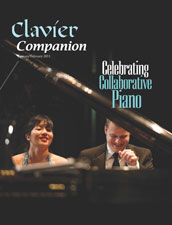We receive a hefty number of wonderful emails, both positive and negative, and we thank everyone who takes the time to share their thoughts with us.
I admit, however, to taking offense when our artistic integrity is called into question. Our websites and videos have never been about show-biz, nor are they simply about virtuosity. They were not created as gimmicks or to be clever.
They were born out of an innate necessity.
Our websites, videos, performances, and compositions are an outcome of the spirit and joy inherent in music-making. They are the result of our desire to create real and authentic links with our audiences.
Our videos are not intended to be clever or “rock-style;” they are designed to enhance the meaning of the music performed. The "Pas de deux" video, for example, aims to intensify the intimacy and nostalgia already inherent in the music. Similarly, our video of the New Account of the Blue Danube Waltzes intends to visually dramatize what the music already conveys: as we wrote in our album’s liner notes, “our kaleidoscopic Blue Danube Fantasy takes the elegance of the Viennese waltz as a point of departure and plunges headlong into the passions that undulate beneath the dance's restrained facade.” We created the "Reimagine" trailers to represent, in a few short minutes, the impact and drama of the entire album and to encourage viewers to invest in the full production, just as a movie trailer intends to do.
Our compositions and arrangements are not pianistically challenging merely for the sake of virtuosity. For example, we wrote the hand crossings into our Libertango arrangement to visually communicate an element of danger: the racing heartbeats, the physical friction, and the charged chemistry between a pair of tango dancers. Many of our compositions and arrangements for four-hands are designed to withstand the demands of a 2000-seat concert hall, unlike so many works from the four-hand repertoire more suited for a living room; this also changes the way we approach the compositional process.
We do not select repertoire to be sensational; we select music that speaks to us, music that we love, and music that makes a statement. When asked to replace John Williams as composers for a Juilliard centennial concert, we chose to use the iconic Star Wars music as our source material for a very simple reason: we love the music. We really do. And we found great joy in making this music our own.
Our presence on the Internet is not simply about self-promotion; we maintain a strong presence on the Internet because we feel it is an effective way to share and discuss music with people, especially young people. It is an exceptional tool with the power to galvanize new classical music listeners. The questions and answers on our website, and the polling booth for that matter, are designed to give us an opportunity to communicate directly with our audiences (we hope to relate to our audiences as real people and not some aloof automatons on stage).
Everything we do is a result of our mission:
To connect with others; to engage, provoke, illuminate; to serve as a conduit for the composer’s voice; to authentically express our inner lives; to share the joy and fulfillment that only music can elicit. …to free the world from the constraints of sleep-inducing concerts. …to demonstrate that classical piano music can serve as a relevant and powerful force in society.
All that we do as musicians is geared toward these goals, is inspired by these goals, and is fueled by these goals.
If we were doing it all for gimmickry or attention, we wouldn’t have accomplished nearly as much (in fact, we’d be downright bored), and we’re confident it wouldn’t be nearly as good.

